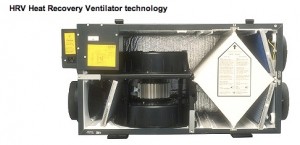 This credit helps ensure that our exposure to indoor air pollutants is reduced by ventilating with outdoor air — definitely a cornerstone of a healthy home. It’s a tradeoff with energy efficiency, though, because most of those credits made sure that exposure to outdoor air was limited, because that wastes energy. The LEED Reference Manual recognizes this:
This credit helps ensure that our exposure to indoor air pollutants is reduced by ventilating with outdoor air — definitely a cornerstone of a healthy home. It’s a tradeoff with energy efficiency, though, because most of those credits made sure that exposure to outdoor air was limited, because that wastes energy. The LEED Reference Manual recognizes this:
From a health perspective, it is important not to underventilate a home. Form an energy perspective, it is important not to overventilate.
It’s a balancing act.
There are three sub-sections: basic outdoor air ventilation (a prerequisite), enhanced outdoor air ventilation (worth 2 points), and third-party testing (one point). The prerequisite is basically that the HVAC contractor should follow the requirements of ASHRAE Standard 62.2-2007, sections 4 and 7 (homes located in mild climates are exempt; Minnesota is not exactly mild, so we are not exempt). What is that standard? It lays out minimum air flow levels for various sized homes. For our home, we need a CFM (cubic feet per minute) air flow of at least 105. There are various strategies to meet the prerequisite: exhaust-only ventilation (not good for hot and humid climates); supply-only ventilation (not great for cold climates); and balanced ventilation with both supply and exhaust fans that ensure an exchange of air between inside and outside. Since we live in an area that is both very hot and very cold, the balanced ventilation system works best. We have it — our variable speed fan has a continuous blower rating of 575 CFM — well over the 105 minimum. (Is our system vastly over-sized?)
For EQ 4.2 Enhanced Outdoor Air Ventilation, we need to have either an HRV or ERV installed. HRVs are Heat Recovery Ventilators; ERVs are Energy Recovery Ventilators. We have an HRV from Venmar, which allows incoming ventilation air to be heated (or cooled) by exhaust air, reducing energy costs associated with space heating (or cooling). ERVs also transfer moisture between outgoing exhaust streams and incoming supply streams, which helps moderate indoor moisture levels in dry winters or humid summer. That’s the LEED Reference Manual’s explanation. I like to think of our HRV as an air pre-heater. If you bring in outdoor air through the whole house ventilation system in the middle of the winter (which is good for a healthy home), it would be freezing cold! Heating it up takes a lot of energy. But if you run it through the duct work that already has warm air, it basically pre-heats the cold air before it gets to the furnace that then heats the air to the temperature we asked for. Complicated? A little, but if you think about it long enough it does make sense from an efficiency standpoint. And from our perspective, we can save on energy bills — so we wanted an HRV with our without the two LEED points awarded for this.
For EQ 4.3 Third-Party Testing, I had assumed we would just get the test done and pick up one point. As I have been learning more about this, though, I had to check with our Green Rater, Jimmie Sparks, from the Neighborhood Energy Connection. His test verified that our ventilation system did move the air in our home at least 105 CFM. He just emailed me tonight: “We did test the flows for your HRV which meet the requirement for ASHRAE 62.2-2007, so yes you get this point.” So, we get two points for planning and designing for a certain minimum air flow, and another point for actually proving that it works!
Indoor Environmental Quality points so far: 4
Cumulative points: 74.5
Additional points needed to get to Gold: 13.5

The points we accrued in this credit just bumped us up from the plain old “LEED Certified” level to the “Silver” level, which was our original goal. Onward toward gold!